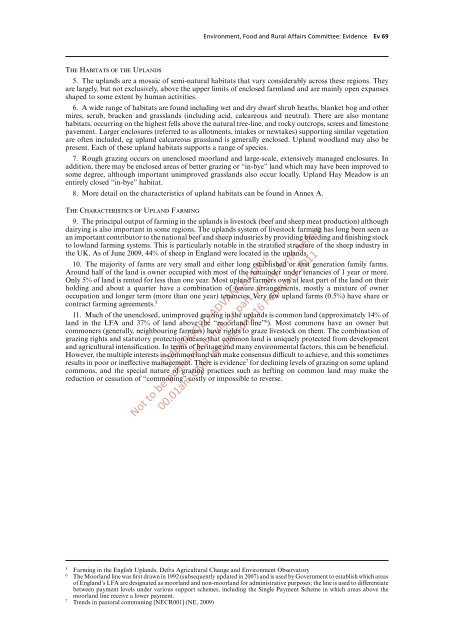Farming in the Uplands - ARCHIVE: Defra
Farming in the Uplands - ARCHIVE: Defra
Farming in the Uplands - ARCHIVE: Defra
Create successful ePaper yourself
Turn your PDF publications into a flip-book with our unique Google optimized e-Paper software.
Environment, Food and Rural Affairs Committee: Evidence Ev 69<br />
The Habitats of <strong>the</strong> <strong>Uplands</strong><br />
5. The uplands are a mosaic of semi-natural habitats that vary considerably across <strong>the</strong>se regions. They<br />
are largely, but not exclusively, above <strong>the</strong> upper limits of enclosed farmland and are ma<strong>in</strong>ly open expanses<br />
shaped to some extent by human activities.<br />
6. A wide range of habitats are found <strong>in</strong>clud<strong>in</strong>g wet and dry dwarf shrub heaths, blanket bog and o<strong>the</strong>r<br />
mires, scrub, bracken and grasslands (<strong>in</strong>clud<strong>in</strong>g acid, calcareous and neutral). There are also montane<br />
habitats, occurr<strong>in</strong>g on <strong>the</strong> highest fells above <strong>the</strong> natural tree-l<strong>in</strong>e, and rocky outcrops, screes and limestone<br />
pavement. Larger enclosures (referred to as allotments, <strong>in</strong>takes or newtakes) support<strong>in</strong>g similar vegetation<br />
are often <strong>in</strong>cluded, eg upland calcareous grassland is generally enclosed. Upland woodland may also be<br />
present. Each of <strong>the</strong>se upland habitats supports a range of species.<br />
7. Rough graz<strong>in</strong>g occurs on unenclosed moorland and large-scale, extensively managed enclosures. In<br />
addition, <strong>the</strong>re may be enclosed areas of better graz<strong>in</strong>g or “<strong>in</strong>-bye” land which may have been improved to<br />
some degree, although important unimproved grasslands also occur locally. Upland Hay Meadow is an<br />
entirely closed “<strong>in</strong>-bye” habitat.<br />
8. More detail on <strong>the</strong> characteristics of upland habitats can be found <strong>in</strong> Annex A.<br />
The Characteristics of Upland <strong>Farm<strong>in</strong>g</strong><br />
9. The pr<strong>in</strong>cipal output of farm<strong>in</strong>g <strong>in</strong> <strong>the</strong> uplands is livestock (beef and sheep meat production) although<br />
dairy<strong>in</strong>g is also important <strong>in</strong> some regions. The uplands system of livestock farm<strong>in</strong>g has long been seen as<br />
an important contributor to <strong>the</strong> national beef and sheep <strong>in</strong>dustries by provid<strong>in</strong>g breed<strong>in</strong>g and f<strong>in</strong>ish<strong>in</strong>g stock<br />
to lowland farm<strong>in</strong>g systems. This is particularly notable <strong>in</strong> <strong>the</strong> stratified structure of <strong>the</strong> sheep <strong>in</strong>dustry <strong>in</strong><br />
<strong>the</strong> UK. As of June 2009, 44% of sheep <strong>in</strong> England were located <strong>in</strong> <strong>the</strong> uplands.<br />
10. The majority of farms are very small and ei<strong>the</strong>r long established or first generation family farms.<br />
Around half of <strong>the</strong> land is owner occupied with most of <strong>the</strong> rema<strong>in</strong>der under tenancies of 1 year or more.<br />
Only 5% of land is rented for less than one year. Most upland farmers own at least part of <strong>the</strong> land on <strong>the</strong>ir<br />
hold<strong>in</strong>g and about a quarter have a comb<strong>in</strong>ation of tenure arrangements, mostly a mixture of owner<br />
occupation and longer term (more than one year) tenancies. Very few upland farms (0.5%) have share or<br />
contract farm<strong>in</strong>g agreements. 5<br />
11. Much of <strong>the</strong> unenclosed, unimproved graz<strong>in</strong>g <strong>in</strong> <strong>the</strong> uplands is common land (approximately 14% of<br />
land <strong>in</strong> <strong>the</strong> LFA and 37% of land above <strong>the</strong> “moorland l<strong>in</strong>e” 6 ). Most commons have an owner but<br />
commoners (generally, neighbour<strong>in</strong>g farmers) have rights to graze livestock on <strong>the</strong>m. The comb<strong>in</strong>ation of<br />
graz<strong>in</strong>g rights and statutory protection means that common land is uniquely protected from development<br />
and agricultural <strong>in</strong>tensification. In terms of heritage and many environmental factors, this can be beneficial.<br />
However, <strong>the</strong> multiple <strong>in</strong>terests <strong>in</strong> common land can make consensus diYcult to achieve, and this sometimes<br />
results <strong>in</strong> poor or <strong>in</strong>eVective management. There is evidence7 for decl<strong>in</strong><strong>in</strong>g levels of graz<strong>in</strong>g on some upland<br />
commons, and <strong>the</strong> special nature of graz<strong>in</strong>g practices such as heft<strong>in</strong>g on common land may make <strong>the</strong><br />
reduction or cessation of “common<strong>in</strong>g” costly or impossible to reverse.<br />
EMBARGOED ADVANCE COPY:<br />
Not to be published <strong>in</strong> full, or part, <strong>in</strong> any form before<br />
00.01am GMT Wednesday 16 February 2011<br />
5 <strong>Farm<strong>in</strong>g</strong> <strong>in</strong> <strong>the</strong> English <strong>Uplands</strong>, <strong>Defra</strong> Agricultural Change and Environment Observatory<br />
6 The Moorland l<strong>in</strong>e was first drawn <strong>in</strong> 1992 (subsequently updated <strong>in</strong> 2007) and is used by Government to establish which areas<br />
of England’s LFA are designated as moorland and non-moorland for adm<strong>in</strong>istrative purposes; <strong>the</strong> l<strong>in</strong>e is used to diVerentiate<br />
between payment levels under various support schemes, <strong>in</strong>clud<strong>in</strong>g <strong>the</strong> S<strong>in</strong>gle Payment Scheme <strong>in</strong> which areas above <strong>the</strong><br />
moorland l<strong>in</strong>e receive a lower payment.<br />
7 Trends <strong>in</strong> pastoral commun<strong>in</strong>g [NECR001] (NE, 2009)

















